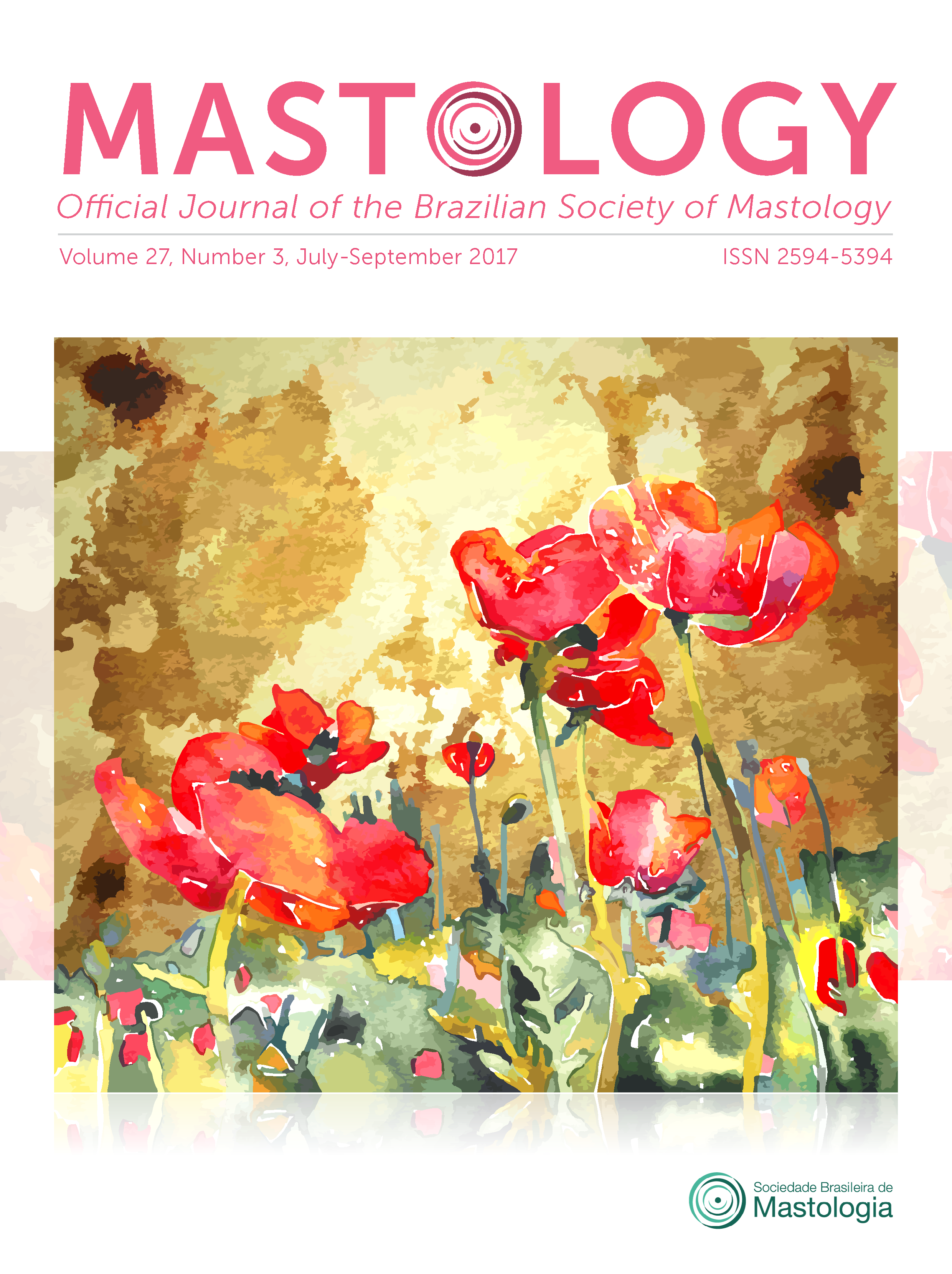Frequência e fatores associados à lesão da veia axilar em mulheres submetidas à linfadenectomia axilar no tratamento cirúrgico do câncer de mama
Palavras-chave:
Neoplasias da mama, Cirurgia, Tratamento, Linfadenectomia, Veia axilarResumo
Objetivo: Avaliar quais variáveis se apresentam como fatores de risco associados à lesão da veia axilar durante a linfadenectomia no tratamento cirúrgico de pacientes portadoras de câncer de mama. Métodos: Estudo retrospectivo realizado por meio da análise de prontuário eletrônico de 1.007 pacientes submetidas a esvaziamento axilar no Hospital Erasto Gaertner, no período de janeiro de 2010 a dezembro de 2014. Foram avaliados, por meio de um questionário padrão, os seguintes possíveis fatores de risco: idade, índice de massa corpórea (IMC), presença de metástase axilar palpável no exame clínico, linfonodo sentinela pré-linfadenectomia, presença de metástase axilar no transoperatório, tamanho da metástase e se estava aderida aos vasos axilares, presença de invasão do músculo peitoral, ressecção do músculo peitoral menor, incisão axilar separada da incisão mamária, radioterapia prévia, quimioterapia neoadjuvante e estadiamento pré e pós-operatório. Para cada paciente que apresentou lesão de veia axilar foi realizado pareamento com dois controles homogêneos (idade, IMC, estadiamento pré-operatório, proposta cirúrgica e tratamento neoadjuvante). Resultados: Treze pacientes apresentaram lesão da veia axilar. Na avaliação transoperatória, em sua grande maioria, a axila estava positiva no grupo da lesão (10 casos = 76,9%) e no grupo controle (12 casos = 46,1%) e encontrava-se aderida aos vasos axilares em 10 casos no grupo da lesão (76,9%) e em 7 (26,9%) no grupo controle. Conclusões: Neste estudo, a presença de metástase axilar na avaliação transoperatória, bem como aderida aos vasos axilares, está associada ao risco aumentado de lesão de veia axilar durante a linfadenectomia.
Downloads
Referências
World Health Organization. International Agency for Research on Cancer. Globocan. 2015.
National Comprehensive Cancer Network. NCCN Clinical Practice Guidelines in Oncology:breast cancer. Version 03. 2013.
American Joint Committee Cancer: Breast. In: Edge SB, Byrd DR, Compton CC, Fritz AG, Greene FL, Trotti A, eds. AJCC Cancer Staging Manual. 7ªedition. New York: Springer, 2010. p. 347-376.
Fuller MS, Lee CI, Elmore JG. Breast cancer screening: an evidence-based update.Med Clin North Am. 2015;99(3):451-68. doi: 10.1016/j.mcna.2015.01.002
SEER Cancer Statistics Review, 1975-2009 (Vintage 2009 Populations). Bethesda:National Cancer Institute; 2009.
Brasil. Ministério da Saúde. Instituto Nacional do Câncer José Alencar Gomes da Silva (INCA). Informativo Vigilância do Câncer n.2. Brasília: Ministério da Saúde; 2012.
Berg JW. The significance of axillary node levels in the study of breast carcinoma. Cancer. 1955;8:776-8.
Zarebczan DB, Neuman HB. Management of the axilla. Surg Clin North Am. 2013;93:429-44.
Warmuth MA, Bowen G, Prosnitz LR, Chu L, Broadwater G, Peterson B, et al. Complications of axillary lymph node dissection for carcinoma of the breast: a report based on a patient survey. Cancer. 1998;83:1362-8.
Salmon RJ, Ansquer Y, Asselain B. Preservation versus section of intercostal-brachial nerve (IBN) in axillary dissection for breast cancer - a prospective randomized trial. Eur J Surg Oncol. 1998;24:158-61.
Schünemann H, Willich N.Lymphödeme nach mammakarzinom. Dtsch Med Wochenschr. 1997;122:536-41.
DiSipio T, Rye S, Newman B, Hayes S. Incidence of unilateral arm lymphoedema after breast cancer: a systematic review and meta-analysis. Lancet Oncol. 2013;14:500-15.
Herd-Smith A, Russo A, Muraca MG, Del Turco MR, Cardona G. Prognostic factors for lymphedema after primary treatment of breast carcinoma. Cancer. 2001;92:1783-7.
Petrek JA, Senie RT, Peters M, Rosen PP. Lymphedema in a cohort of breast carcinoma survivors 20 years after diagnosis. Cancer. 2001;92:1368-77.
Kissin MW, Querci della Rovere G, Easton D,Westbury G. Risk of lymphoedema following the treatment of breast cancer. Br J Surg. 1986;73(7):580-4.
Lin PP, Alison DC, Wainstock J, Miller KD, Dooley WC, Friedman N,et al. Impact of axillary lymph node dissection on the therapy of breast cancer patients. J Clin Oncol. 1993;11:1536-44.
Ashikari R, Huvos AG, Snyder RE. Prospective study of noninfiltrating carcinoma of the breast. Cancer. 1977;39:435-9.
Solin LJ, Fowble BL, Schultz DJ, Yet IT, Kowalyshyn MJ, Goodman RL. Definitive irradiation for intraductal carcinoma of the breast. Int J Radiat Oncol Biol Phys. 1990;19:843-50.
Wong JH, Kopald KH, Morton DL. The impact of microinvasion on axillary node metastases and survival in patients with intraductal breast cancer. Arch Surg. 1990;125:1298-302.
Nevin JE, Pinzón G, Morán TJ, Baggerly JT. Minimal breast carcinoma. Am J Surg. 1980;139:357-9.
Schuh ME, Nemoto T, Penetrante RB, Rosner D, Dao TL. Intraductal carcinoma. Analysis of presentation, pathologic findings and outcome of disease. Arch Surg. 1986;121:1303-7.
Kinne DW, Petrek JA, Osborne MP, Fracchia AA, DePalo AA, Rosen PP. Breast carcinoma in situ. Arch Surg. 1989;124:33-6.
Chadha M, Chabon AB, Friedmann P, Vikram B. Predictors of axillary metastases in patients with T1 breast cancer. A multivariate analysis. Cancer. 1994;73:350-3.
Harris J, Ostenn R. Patients with early breast cancer benefit from effective axillary treatment. Breast Cancer Res Treat. 1985;5:17-21. doi: 10.1007/BF01807645
Veronesi U, Cascinelli N, Mariani L, Greco M, Saccozzi R, Luini A, et al. Twenty-year follow-up of a randomized study comparing breast-conserving surgery with radical mastectomy for early breast cancer. N Engl J Med. 2002;347:1227-32. doi: 10.1056/NEJMoa020989
Hayes SC, Janda M, Cornish B, Battistutta D, Newman B. Lymphedema after breast cancer: incidence, risk factors, and effect on upper body function. J Clin Oncol. 2008,26:3536-42.
Pain SJ, Vowler S, Purushotham AD. Axillary vein abnormalities contribute to development of lymphoedema after surgery for breast cancer. Br J Surgery. 2005,92:311-5.
Rett MT, Lopes MCA. Fatores de risco relacionados ao linfedema. Rev Bras Mastol. 2002;12:39-42.
Johansson K, Ohlsson K, Ingvar C, Albertsson M, Ekdahl C. Factors associated with the development of arm lymphedema following breast cancer treatment: a match pair case-control study. Lymphology. 2002;35:59-71.
Rett MT, Lopes MCA. Fatores de risco relacionados ao linfedema. Rev Bras Mastol. 2002;12:39-42.
Andac MH. Cardiovascular Injuries, Emergency and Trauma. Ankara: Handbook; 1997. p. 229-250.
Andrikopoulos V, Antoniou I, Panoussis P. Arterial injuries associated with lower-extremity fractures. Cardiovasc Surg. 1995;3(1):15-8.
Carrel A. La téchnique opératoire des anastomoses vasculaires et la transplantation de viscères. Lyon Méd. 1902;98:859-64.
Carrel A. The surgery of blood vessels. Johns Hopkins Med J. 1907;18-28.
Brito CJ, Silva RM. Cirurgia Vascular: Cirurgia Endovascular, Angiologia. São Paulo: Revinter; 2014.
Rutherford RB. Atlas of vascular surgery: basic techniques and exposures. Philadelphia: WB Saunders; 2000.p. 486-93.
Best CH. Heparin and vascular occlusion. Can Med Assoc J. 1936;35:621-2.
Downloads
Publicado
Como Citar
Edição
Seção
Licença
Copyright (c) 2017 Rafaela Miranda Corrêa, Danila Pinheiro Hubie, Reitan Ribeiro, José Clemente Linhares, Sérgio Bruno Bonatto Hatschbach

Este trabalho está licenciado sob uma licença Creative Commons Attribution 4.0 International License.







